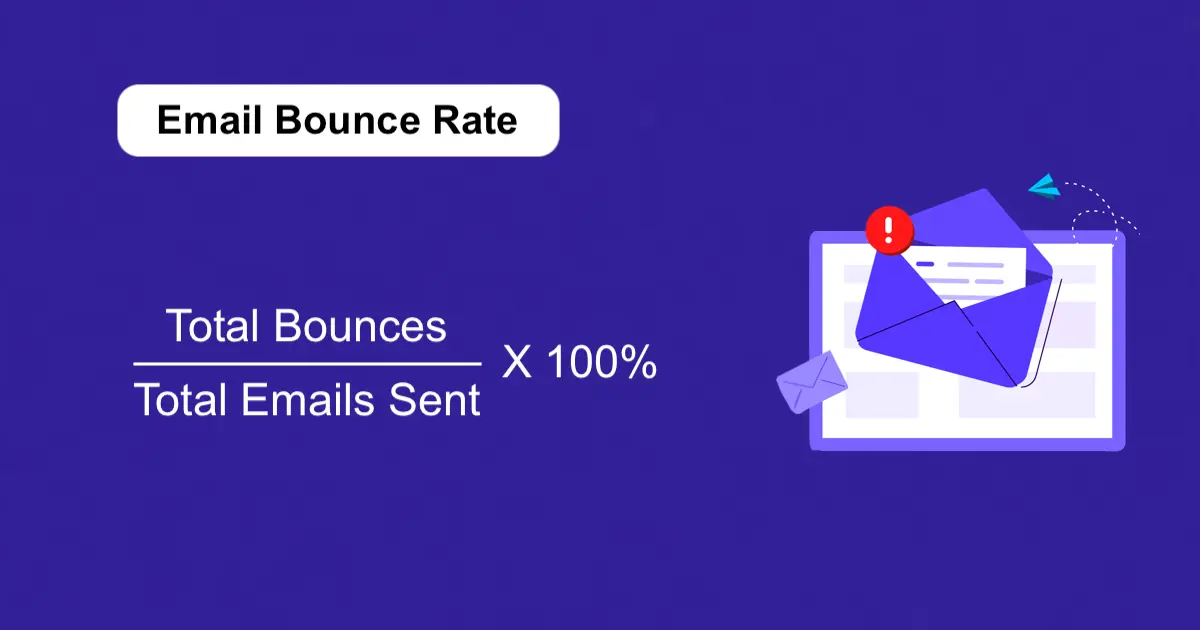How to Measure the Bounce Rate of Your Emails
This guide explores how to measure email bounce rates, the implications of high bounce rates, and how our services can assist you in managing and improving your email marketing efforts.

Measuring the bounce rate of your emails is crucial for understanding the effectiveness of your email campaigns and maintaining a healthy sender reputation. Bounce rates provide insights into how many of your emails were not successfully delivered, helping you troubleshoot issues and optimize your email marketing strategy. This guide explores how to measure email bounce rates, the implications of high bounce rates, and how our services can assist you in managing and improving your email marketing efforts.
Understanding Email Bounce Rate
What is Email Bounce Rate?
The bounce rate in email marketing refers to the percentage of emails that were not successfully delivered to recipients' inboxes. Bounces can be classified into two types:
- Hard Bounces: Permanent delivery failures due to invalid email addresses or non-existent domains.
- Soft Bounces: Temporary delivery issues such as full mailboxes, server problems, or temporary email address issues.
Why is Measuring Bounce Rate Important?
Measuring bounce rate is important because:
- Sender Reputation: High bounce rates can negatively impact your sender reputation and deliverability.
- List Hygiene: Identifies invalid email addresses that should be removed from your list.
- Campaign Effectiveness: Provides insights into the accuracy of your email list and the quality of your email content.
How to Measure Email Bounce Rate
Use Email Marketing Platforms
Most email marketing platforms offer built-in analytics tools to measure bounce rates:
- Access Reports: Log in to your email marketing platform and navigate to the campaign report section.
- Find Bounce Metrics: Locate metrics related to email bounces, typically labeled as "Bounce Rate," "Hard Bounces," and "Soft Bounces."
Calculate Bounce Rate Manually
To calculate the bounce rate manually:
- Obtain Bounce Data: From your email campaign report, note the total number of emails sent and the number of bounced emails.
- Use the Formula: Bounce Rate(%)=(Number of Bounced EmailsTotal Number of Sent Emails)×100\text{Bounce Rate} (\%) = \left(\frac{\text{Number of Bounced Emails}}{\text{Total Number of Sent Emails}}\right) \times 100Bounce Rate(%)=(Total Number of Sent EmailsNumber of Bounced Emails)×100
- Example Calculation: If you sent 1,000 emails and 50 bounced, the bounce rate would be: Bounce Rate=(501000)×100=5%\text{Bounce Rate} = \left(\frac{50}{1000}\right) \times 100 = 5\%Bounce Rate=(100050)×100=5%
Analyze Bounce Reports
Most platforms provide detailed bounce reports:
- Hard Bounce Details: Review specific reasons for hard bounces, such as invalid email addresses or domain issues.
- Soft Bounce Insights: Examine temporary issues that caused soft bounces, such as server problems or full mailboxes.
Addressing High Bounce Rates
Reasons for High Bounce Rates
High bounce rates can result from several factors:
- Invalid Email Addresses: Addresses that no longer exist or are incorrectly entered.
- Spam Traps: Addresses set up to catch spammers, which can be flagged if included in your list.
- List Quality: Outdated or purchased email lists with numerous invalid addresses.
- Technical Issues: Problems with your email server or email content that lead to delivery failures.
Improving Email List Hygiene
To reduce bounce rates:
- Regularly Clean Your List: Remove invalid or inactive email addresses regularly.
- Use Verification Tools: Employ email verification tools to validate addresses before sending campaigns.
- Encourage Opt-Ins: Use double opt-in methods to ensure that subscribers genuinely want to receive your emails.
Monitor and Optimize Campaigns
Regularly monitor bounce rates and optimize campaigns:
- Track Performance: Continuously review bounce metrics and campaign performance.
- Adjust Content: Modify email content and sending practices based on bounce reports and feedback.
- Test Deliverability: Use tools to test your email deliverability and identify potential issues before sending.
Our Offer: Email Bounce Rate Management Services
To help you manage and optimize your email bounce rate, we offer a range of specialized services:
Email List Cleaning and Verification
Our services include:
- List Cleaning: Remove invalid and inactive email addresses from your list.
- Verification Tools: Use advanced tools to validate email addresses before sending campaigns.
Bounce Rate Analysis and Reporting
We provide detailed analysis and reporting:
- Comprehensive Reports: Receive detailed bounce reports that highlight hard and soft bounces.
- Root Cause Analysis: Identify and address the root causes of high bounce rates.
Campaign Optimization
Optimize your email campaigns with our support:
- Content Review: Assess and improve your email content to reduce bounce rates.
- Deliverability Testing: Test and enhance email deliverability to improve overall campaign effectiveness.
Ongoing Monitoring and Support
Benefit from ongoing support:
- Regular Monitoring: Track bounce rates and email performance continuously.
- Expert Guidance: Receive expert advice and recommendations to maintain a healthy email list and improve engagement.
Getting Started
To start optimizing your email bounce rate, follow these steps:
- Contact Us: Reach out via our website, email, or phone to discuss your needs and goals.
- Schedule a Consultation: Book a consultation to explore how our services can benefit your email marketing efforts.
- Receive a Proposal: Obtain a customized proposal outlining our approach and services for managing and improving your bounce rates.
Contact Us Today
Ready to reduce your email bounce rate and enhance your email marketing performance? Contact us today to discover how our email bounce rate management services can help you achieve your marketing goals. Our expert team is dedicated to providing you with the tools and support you need for successful email campaigns.
Final Thought
Measuring and managing the bounce rate of your emails is essential for maintaining a healthy sender reputation and improving campaign effectiveness. By using email marketing platforms, calculating bounce rates manually, and addressing high bounce rates through list hygiene and optimization, you can enhance your email marketing strategy. Explore our services to receive expert support in managing bounce rates, optimizing campaigns, and achieving better email marketing results.
FAQ:
1. What is an email bounce rate?
An email bounce rate is the percentage of emails that could not be delivered to the recipients' inboxes. Bounces are classified as:
- Hard Bounces: Permanent delivery failures due to reasons like invalid email addresses or non-existent domains.
- Soft Bounces: Temporary delivery issues such as full mailboxes or server problems.
2. Why is it important to measure email bounce rates?
Measuring bounce rates is crucial for:
- Maintaining Sender Reputation: High bounce rates can harm your sender reputation and impact future deliverability.
- List Management: Helps in identifying and removing invalid email addresses from your list.
- Improving Campaign Effectiveness: Provides insights into the accuracy of your email list and effectiveness of your email content.
3. How can I measure the bounce rate of my emails?
To measure bounce rates:
- Use Email Marketing Platforms: Most platforms provide built-in metrics for bounce rates. Check your campaign reports for bounce statistics.
- Calculate Manually: Obtain the number of bounced emails and the total number of sent emails from your reports and use the formula: Bounce Rate(%)=(Number of Bounced EmailsTotal Number of Sent Emails)×100\text{Bounce Rate} (\%) = \left(\frac{\text{Number of Bounced Emails}}{\text{Total Number of Sent Emails}}\right) \times 100Bounce Rate(%)=(Total Number of Sent EmailsNumber of Bounced Emails)×100
4. What are the typical bounce rate benchmarks?
Typical bounce rate benchmarks vary by industry, but a common standard is:
- Good Rate: Less than 2%
- Moderate Rate: 2% - 5%
- High Rate: Above 5%
5. What causes high bounce rates in email campaigns?
High bounce rates can be caused by:
- Invalid Email Addresses: Addresses that no longer exist or are entered incorrectly.
- Spam Traps: Addresses designed to catch spammers.
- Poor List Quality: Outdated or purchased email lists with invalid addresses.
- Technical Issues: Problems with your email server or email content.
6. How can I reduce high bounce rates?
To reduce bounce rates:
- Clean Your Email List Regularly: Remove invalid and inactive email addresses.
- Use Email Verification Tools: Validate addresses before sending campaigns.
- Encourage Opt-Ins: Implement double opt-in methods to ensure subscribers genuinely want to receive your emails.
- Monitor and Optimize Campaigns: Regularly review bounce metrics and adjust your campaigns based on insights.
7. What should I do if I have a high bounce rate?
If you have a high bounce rate:
- Analyze Bounce Reports: Review detailed reports to understand the reasons for bounces.
- Address List Issues: Remove invalid addresses and use verification tools.
- Improve Content and Sending Practices: Optimize email content and sending practices to reduce delivery issues.
- Consult with Experts: Seek advice from email marketing professionals to address persistent problems.
8. How often should I clean my email list?
Regular list cleaning should be performed:
- Quarterly: For general maintenance and to keep your list up-to-date.
- Before Major Campaigns: To ensure high-quality deliverability before sending large campaigns.
9. Can email bounce rates impact my email deliverability?
Yes, high bounce rates can negatively impact your email deliverability by:
- Harming Sender Reputation: ISPs may flag your emails as spam or reduce deliverability.
- Reducing Inbox Placement: Your emails may end up in spam folders rather than the inbox.
10. What tools can help me manage email bounce rates?
Useful tools for managing bounce rates include:
- Email Verification Services: Tools like NeverBounce, ZeroBounce, and Hunter for validating email addresses.
- Email Marketing Platforms: Platforms like Mailchimp, SendGrid, and Constant Contact offer built-in bounce rate tracking and management features.
- Deliverability Testing Tools: Tools such as Litmus and Email on Acid for testing email deliverability and identifying potential issues.
11. How can I integrate bounce rate management into my email marketing strategy?
To integrate bounce rate management:
- Monitor Regularly: Continuously track bounce rates and email performance.
- Update Lists Frequently: Regularly clean and validate your email list.
- Optimize Campaigns: Adjust email content and sending practices based on bounce data and feedback.
- Seek Professional Help: Consider working with experts to manage and optimize your email marketing strategy.
12. What services do you offer for managing email bounce rates?
We offer comprehensive services including:
- Email List Cleaning and Verification: Regularly remove invalid addresses and validate email lists.
- Bounce Rate Analysis and Reporting: Provide detailed reports and root cause analysis for high bounce rates.
- Campaign Optimization: Review and improve email content and sending practices.
- Ongoing Monitoring and Support: Track performance and offer expert advice for continuous improvement.
13. How can I get started with your bounce rate management services?
To get started:
- Contact Us: Reach out via our website, email, or phone to discuss your needs.
- Schedule a Consultation: Book a consultation to explore how our services can benefit your email marketing efforts.
- Receive a Proposal: Obtain a customized proposal outlining our approach and services.
14. How long does it take to see improvements in bounce rates?
Improvements can be observed:
- Short-Term: Within a few weeks after cleaning your list and optimizing campaigns.
- Long-Term: Continuous monitoring and adjustments will lead to sustained improvements over time.
15. What are the costs associated with bounce rate management services?
Costs vary based on:
- Scope of Services: The extent of list cleaning, verification, and campaign optimization needed.
- Size of Your Email List: Larger lists may require more extensive cleaning and management.
- Frequency of Services: Regular versus one-time services.
We provide detailed proposals with cost estimates based on your specific requirements and goals.
Get in Touch
Website – https://www.webinfomatrix.com
Mobile - +91 9212306116
WhatsApp – https://call.whatsapp.com/voice/9rqVJyqSNMhpdFkKPZGYKj
Skype – shalabh.mishra
Telegram – shalabhmishra
Email - info@webinfomatrix.com
What's Your Reaction?






















